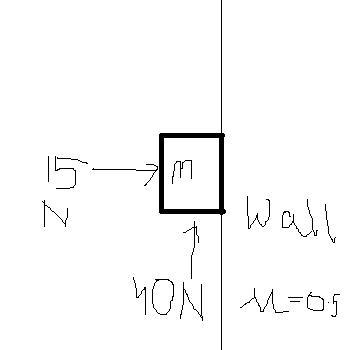[45]
plz post the solution
24 Answers
virang
m not getting regarding the direction of friction b/w the upper and lower block.
can u xplain it in a bit detail???????
At the beginning v=v rite.
But there is relative motion between the block and ground and therefore friction acts on the lower block
This results in reduction of velocity and therefore relative velocity of the upper block is more than the the lower block
At the begining this will be the case
But The friction of the ground and the lower block is higher than The friction of the upper block and the lower block and therefore
Therefore Relative velocity of upper block with respect to lower block is more
Therefore Relative velocity of upper block with respect to lower block is more
y????????
my method is right
In this sum both the block given velocity v
Therefore Relative velocity of upper block with respect to lower block is more therefore the friction is backward and this will result in a forward force in lower block (newton's third law)
Got it ?
See the friction between the upper and lower block will provide a force in backward diretion on the upper block and forward direction on the lower block
Thats wat i think may be wrong
And therefore it results in 2μ(M+m)g- μmg/2M this
Distance travelled by the lower block = S
Therefore distance by the upper block has to S + L = D
For lower block
Force of friction = μ(M+m)g
Forward push due to reaction of For upper block
Force of friction = μmg/2
Deceleration of M is 2μ(M+m)g- μmg/2M
S = vt - μ(M+m)gt2/2M
For upper block
Force of friction = μmg/2
Deceleration for m = μg/2
D = vt - μgt2/4
D - S = l
vt - μgt2/4 - vt + μ(M+m)gt2/2M =L
t2[-μg/4 +2μ(M+m)g-μmg/4M] =L
t2[(-Mμg + 2μMg +2μmg-μmg)/4M] = L
t2 = 4LM/μg(M + m)
The direction of friction is in "along" the plane of the wall.
The thing is that it is opposite to the resultant of 15 N force and Mg
[url=http://targetiit.com/iit_jee_forum/posts/friction_any1_63_63_63_774.html]Friction problem from HC Verma[/url]
I took it in the horizontal plane since the force is horizontal
F = mg
F = 2*10
F = 20 N
N = 15N
f = μN
f = 0.5*15
f = 7.5N
Total force against 40N = 20+7.5 = 27.5N
Yes the block will move in the upward
Direction
Resultant upward force = 12.5N
tan θ = 12.5/15
tan θ = 2.5/3
θ = tan-10.8333
But it looks that the question is not framed properly
